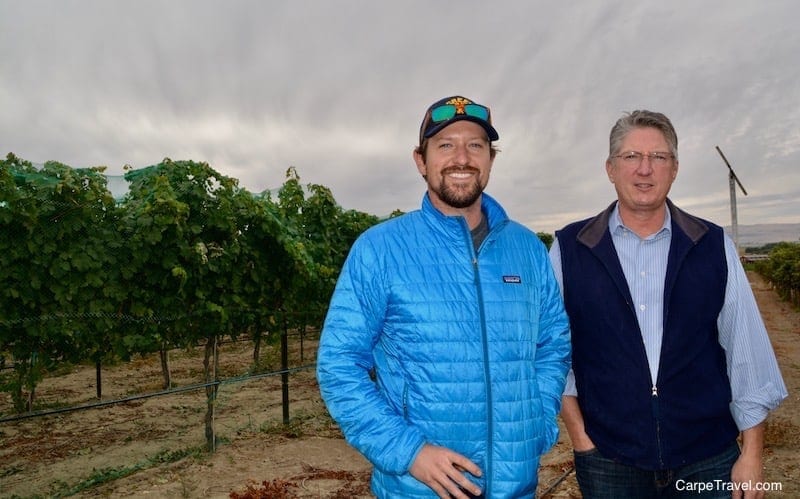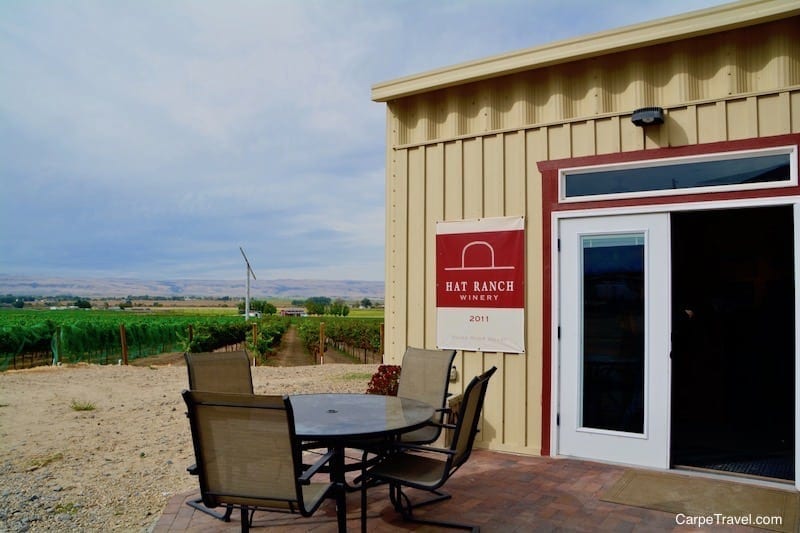Pioneering the great new frontier of the Idaho wine industry
Welcome back to Carpe Travel’s Interview with a Winemaker series. It’s been awhile since I last shared an interview, but as I’m focusing more on travel within wine regions in the United States I’ll be talking to a lot of local winemakers who are shaping their regions. So get ready!
I met Tim Harless, owner and winemaker at Hat Ranch Winery in Idaho about this time last year. It was nearly harvest and like his wines, his story was rich and ready to be shared.
As a commercial airline pilot Tim took an unconventional path into winemaking. If there even is a conventional path… After a visit to Into the Glass Wine Bar & Texas Café in 2002 Tim’s interest and path into winemaking was laid. His travels and hobbies became immersed in learning about and sipping wines from all over the country…and the world. His passion for wine then lead him to begin Viticulture & Enology training through a local community college. He became was so engrossed that he pursued ways to use his vacation time to develop internships for himself in California’s wine country.
Fast forward 15 years. Tim is now the owner and winemaker of an award-winning winery in the Snake River Valley AVA (wine region), about 20 minutes outside of Boise, Idaho. Sip in more of Idaho with our Idaho Wine Travel Guide.
Tell us how Hat Ranch Winery was born.
The Hat Ranch name and logo were inspired by our pioneering ancestors who set out from Colorado to Tensleep, Wyoming in 1902 to make a new life in the Great Northwest. The name and logo were taken from letterhead of the stationary from the original homestead and cattle ranch my family established, which lasted about 60 years. When my wife Helen and I decided to launch a vineyard, we purchased land in Idaho, which was also home to an early 1900s farmhouse. We re-established the Hat Ranch name in Idaho as our winemaking homestead, the great new frontier of the wine industry.
When people visit Boise, what are the top three things you think they should go/do/see?
Three that’s all I get? There’s so much to do in Boise!
We were drawn here because of the abundance of activities. Outdoor both summer and winter, music, just about any genre, and the local food, winery, brewery, and spirits artists. Our first time visitors always tell us how amazed they are at what is happening in Boise.
When did you fall in love with wine? Do you remember the wine that was “the one” that started it all? Is there a story behind it?
I think it was more of a “filling the vessel drop by drop till it runs over” thing. Learning to appreciate the differences between so called international varieties from different regions while coming to understand why a particular region might have an especially good grape was fascinating.
What is your background as a winemaker? Where have you studied viticulture (other countries, wineries, etc.)?
I started making kits years ago just because they were easy. Soon I was looking for small lots of grapes to buy for home winemaking. After a few successes and probably more failures, I enrolled in classes at Grayson Community College in Texas in both Enology and Viticulture. The college brought in Barry Gump and Murli Dharmadhikari both great instructors.
Pretty soon I was tearing out portions of my yard where I lived in Texas to plant grapes. I used my vacation time to intern a couple weeks at Vino Noceto in Amador county. retty soon I was looking for vineyard spots in California and the Northwest.
My hobby had officially gone wild.
Are there any memories / lessons you learned in your training that have stuck with you?
On the first day of my Enology and Viticulture class there was a pop quiz posted on the board. It was just one question.
“I want to make a wine that _______.”
There was some exceptional answers from many in the class about styles, varietals, etc. When it was my turn, I simply answered “SELLS!” That’s where we stopped going around the room so I hope I got it right!
What resources would you reference for people who want to learn about wine? From a novice to more advanced.
Perhaps the easiest is to ask the tasting room staff when visiting a tasting room. You can certainly learn about their wines and the local or regional specifics. Attending a winemaker dinner is a great chance to learn about wine. There are also wine appreciation classes taught at colleges, universities, and private entities, like House of Wine here in Boise. Past that, you should probably enroll in an Enology class.
What are some of the misconceptions/phrases you hear from people regarding wine that are simply not true (or drive you crazy)?
I am over the “Potato Wine” joke. People use it too often when regarding Idaho wines. Please leave it at home.
What is your winemaking philosophy?
I am committed to producing the best wine possible with fruit grown in Idaho, primarily the Snake River Valley AVA. I want to embody the vigneron model with our six acres of Sauvignon Blanc, Muscat Ottonel, Cabernet Franc, and Tempranillo going directly into an “Estate Grown” designation.
How does your approach differ from other winemakers in Idaho?
Having our own vineyard to source from helps me appreciate the vagaries of farming that other growers experience. Also realizing that a great deal of the work goes into the vineyard before the grapes are harvested. The winemaking challenges can vary greatly depending on the fruit and my goal is to make it really easy to make wine with our own fruit.
The Idaho wine regions are still considered new players in the world of wine. If there is one thing you could tell people about the Idaho wine scene, what would it be?
They will be amazed with the quality of the wines they are getting and pleased with the value delivered.
Hat Ranch alone won six Silvers and one Gold Medal at the 2016 San Francisco Chronicle Wine Competition. We are on the right track as a winery and as an industry.
What do you see as the biggest challenge/s in producing wine in Idaho?
We are lucky enough to have contracts in place and estate fruit to draw from. We need more of the right kinds of grapes in the ground if we are to expand the industry here in Idaho. Other winemakers, weather by necessity, convenience or preference, have chosen to import fruit from other states. It can blur the lines between what is considered “Idaho wine”.
What wine varietals are grown mostly in Idaho? How do these compare to what you’re growing? And what wine varietals do you see doing better than others in Idaho. Why is that?
I think there is some rotation into more reds at some vineyards. I especially like Malbec, Syrah, Tempranillo, and Petit Verdot. We make Cabernet and Merlot as well and I understand there are some new Cab clones planted with a few days shorter ripening season. Our Estate Muscat Ottonel suffered no damage during two cold events when other vineyards took a hit. Viognier is strong, and there seems to be plenty of Chardonnay and Riesling around. We will see how our Sauvignon Blanc does thru a few winters.
Visit Hat Ranch Winery
The tasting room is open Wednesday, Thursday, Friday, Saturday, Sunday from 12pm to 5 pm.
Location: Hat Ranch Winery is located on the Sunnyslope Wine Trail at the intersection of Plum Road and Pear Lane. 15343 Plum Rd Caldwell, ID 83607





